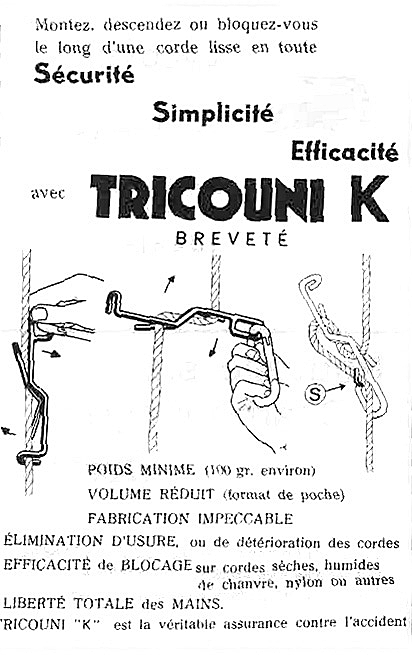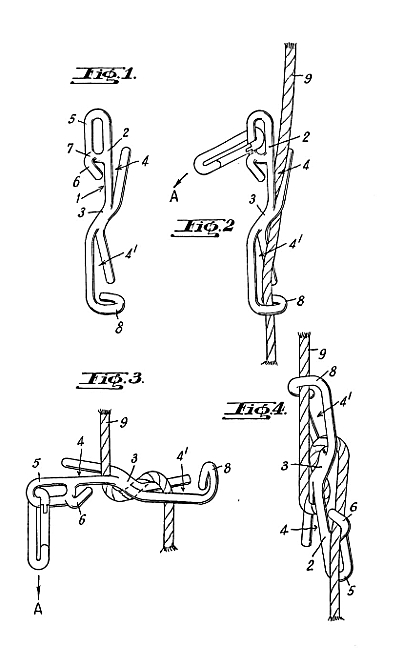Technical Details
I acquired these ascenders used on eBay from Anthony Burdett
in 2008.
Each ascender is made from three 7.1 mm. steel rod. The
main leg has a 13.1 mm. i.d. horizontal hook at the bottom,
ascends 66 mm., dog-legs 21 mm. at about a 30° angle
with the horizontal, ascends another 68 mm., and then loops
downward to form a 29.5 mm. tall, 14.3 mm. wide, welded
eye. A second piece welded to the dog-leg is bent to form two
V notches, each about 50 mm. long. The final piece is
welded to the top of the eye and forms an 11.1 mm. hook that
slopes downward at about 45°. All exposed rod ends are rounded.
One of the two is cadmium plated, the other is not.
The eye has "BREVETE+" and "TRICOUNI K8/12"
stamped on each side
Anthony sent me a letter explaining this ascender, and included
the following comments:
Here are the Stubai Karabiner K
climbing irons, one left and one right but I have forgotten
which is which. They are of different colours.
I have virtually forgotten how
to use them on a single hanging rope but as a guide to help you
work it out, the ends attached to the two short lengths of nylon
rope [i.e., the eyes; Anthony had slings tied to
the eyes] must be uppermost initially
then pulled down through 180° to grip, the two small hooks
engaging the rope to be climbed.
They are remarkably effective
and efficient, but I presume that climbing devices with a cam
are simpler.
When rigging the irons, the standing line goes through the
lower hook and then outside the dog-leg (between the prongs), without any wrapping
around any pieces of the irons. When applying load, just guide
the iron so that it rotates in the direction toward the eye (i.e.,
the top moves toward the outside in the "front" photo) and so that the
standing line engages the two V notches. The standing line
will come out of the lower hook as the iron rotates. The upper
hook is not needed for normal climbing, but the user can engage
it to provide more security if needed (e.g., when stopping to
perform some other activity). When releasing load, guide the iron
so that the rope engages the lower hook, and then slide the iron
upward for the next step. The entire process is simpler than my
description suggests, and works better than one might expect.
I'm not sure that I've matched the manufacturer’s intent for
which iron is the left and which is the right, but using them
this way puts the V notches facing the climber.
History
In 1955, Werkgen Fulpmes started marketing various products with the "Stubai" name. In the next few years they gradually used the "Stubai" name for more products. The "Stubai"–inside–a–diamond logo appeared in 1958. Werkgen Fulpmes officialy adopted the "Stubai" company name in 1960, and subsequently marketed all their items under the Stubai brand name. They used the diamond logo until the 1970s, when they changed the logo to a 3–peak mountain with "STUBAI" within the mountain.
Pascal Ducimetière invented the Climbing Irons in 1965. Tricouni received Swiss Patent #CH428520 for them in January 1967. They received British Patent #GB1116274 (in English!) in June, 1968.

For far more content, use a larger monitor and a full-width window.
Hundreds of cell phone users complained and asked me to for a simpler, mobile friendly site. In particular, they wanted me to limit each page to a small number of pictures and minimize my use of text. This new site provides what they asked for.



